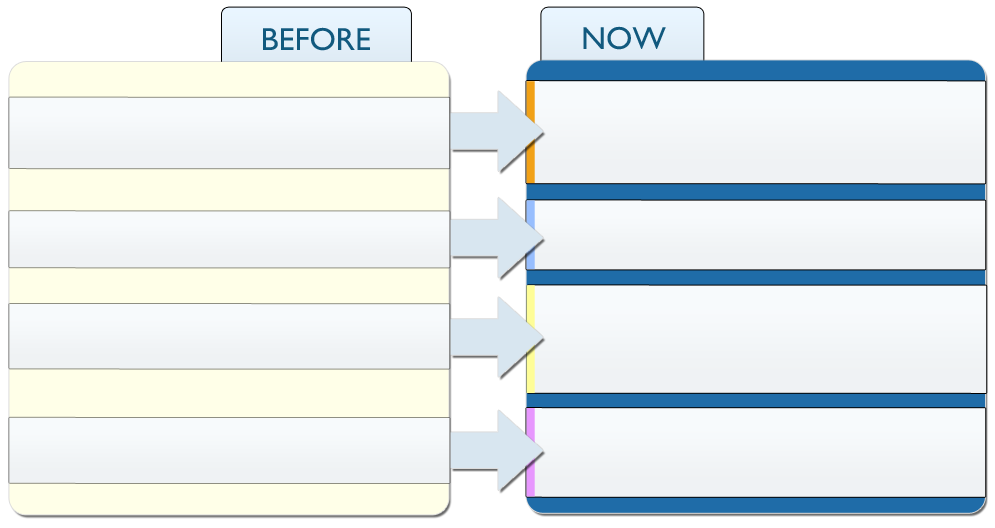

What are they?
Based on the most current research on science and science learning, the Framework for K–12 Science Education, released in 2011, and the Next Generation Science Standards present a new vision for science education. The Framework identifies the science ideas, content, and practices K–12 students should know and it guides effective science education. The Standards, developed through a state-led effort, are based on the Framework and provide guidelines for enacting the vision.
But how is this new vision different?
The new vision emphasizes deeper understanding of a few core ideas, crosscutting concepts, and student engagement in the practices of science and engineering. Moreover, COHERENCE is key. Core ideas, crosscutting concepts, and practices must cohere across grades as a progression, each one supporting the other and developing systematically over multiple years. There also must be coherence across the curriculum, instruction, and assessment within each grade.

- School science commonly was organized by grade level around disconnected topics and addressed discrete facts.
- Emphasis was placed on science knowledge.
- All concepts were given relatively equal weight and attention.
- Coherence of curriculum, instruction, and assessments with standards was limited.
- School science now emphasizes understanding of a few core ideas that develops over time and
deepens from grade to grade.
- Emphasis not only on knowledge, but also on science practices that build and deepen that knowledge.
- Emphasis on a few essential core ideas and concepts that cross disciplinary
boundaries (crosscutting concepts) and provide an
organizational framework for science knowledge.
- Curriculum, instruction, and assessment align with the standards, target the same goals, and together support learning within grades and
across grades.


What is the Inquiry Curriculum?
The Inquiry Curriculum is a grade 3–5 progression of coherent study about the core idea of Matter:
Learning is organized around questions to be investigated. But answers are not enough in the Inquiry Curriculum. Students must OWN the evidence behind their reasoning. They work collaboratively with peers, use data to construct explanations, and assess their ideas and those of others. A culture of scientific talk and practice develops as well as deeper understanding.
Each investigation question is designed to deepen students’ understanding of the disciplinary core idea, the practices of science, and the crosscutting concepts.
Does the Inquiry Curriculum reflect the vision outlined in the Framework and Standards?
Let’s take a look . . .
Weight
The weight of objects can be compared using a pan balance and standard (gram) units.Volume
Two solid objects cannot occupy the same space.
The amount of 3D space that objects occupy can be compared.Material
Objects can be described in terms of their weight and volume and the materials they are made of (clay, cloth, paper, etc.).
Materials have observable physical properties such as color, size, texture, flexibility, etc.
Same size objects can have different weights when they are made of different materials.
Matter
Materials can be subdivided into small pieces and the pieces still have weight.
Weight
The weight of solids and/or liquids can be compared using a digital scale and can be represented on a weight line or a table.
Weight is conserved during crushing and reshaping Liquid and solid volumes can be measured in cubic centimeters.
Volume
Weight is conserved during crushing and reshaping Liquid and solid volumes can be measured in cubic centimeters.
When immersed, a solid displaces a liquid volume equal to the solid volume.
Material
The relationship between weight and volume (i.e. density) is a property of solid and liquid materials.Matter
Matter can be divided into tiny pieces, and even the tiniest pieces have weight and take up space.
Weight
Weight is conserved during dissolving, freezing, melting, evaporation and condensation.Volume
Volume may not be conserved in phase change.Material
Air is a mixture of gaseous materials composed of particles too small and spread apart to see.
Melting, freezing, evaporation and condensation change the form of matter but do not change the material.
Matter
Matter is composed of particles that have weight, occupy space, and are too small to see.
Gases, liquids and solids are all forms of matter and have weight and take up space.

All eight practices are integral to the Inquiry Curriculum
In the Inquiry Curriculum investigations begin with a question. The question is the organizing element. Students use their investigation data as the basis for answering the question. They return to the investigation question often to take stock of how their ideas change.
1
Asking questions and defining problems
More Info
Scientists and engineers use and develop models: 1) to represent or describe phenomena, 2) to help develop questions and explanations, and 3) to communicate ideas to others.
Students make annotated drawings and graphical representations of their findings and use these to build an increasingly sophisticated model of matter. They begin with the conceptual model that materials maintain their identity as they are divided into smaller pieces. And, by the end of grade 5 they are able to describe transformations of water in terms of particles too small to see.
2
Developing and using models
More Info
Students carry out investigations about the nature of matter. They observe, measure, and record weight and volume data, and use their own evidence to construct explanations.
3
Planning and carrying out investigations
More Info
With support, students create and use weight lines, tables, and graphs to organize their data. They look for patterns and relationships and learn that they can use weight data to keep track of the amount of matter.
4
Analyzing and interpreting data
More Info
Students learn that mathematics is an important part of science. In their Inquiry studies, they measure weights and volumes to compare the properties of objects and materials. They come to understand that weight is a measure of how much matter is present.
5
Using mathematics and computational thinking
More Info
Students use evidence from their investigation experience and their evolving model of matter to explain objects and phenomena in their everyday world.
6
Constructing explanations and designing solutions
More Info
Students use evidence from their investigation experience and their evolving model of matter to explain objects and phenomena in their everyday world.
7
Engaging in argument from evidence
More Info
Inquiry experiences end with an all-class meaning making discussion about the investigation question. During the discussion, teachers strategically use “talk moves” to encourage student to make and evaluate evidence-based claims.
8
Obtaining, evaluating, and communicating information
More Info

The Framework identifies seven important concepts that bridge disciplinary boundaries. These concepts help students to connect knowledge from different disciplines into a coherent view.
Patterns
In the Inquiry Curriculum students note patterns in their observations, and use those patterns to raise questions and develop explanations about the materials and phenomena they investigate.
Cause and Effect
As students investigate phenomena involving water displacement, evaporation and condensation, and melting and freezing they ask, “Why did that happen?” and look for patterns in their data to help explain why changes occurred.
Scale, Proportion, and Quality
Scale, proportion, and quantity— In the Inquiry Curriculum, students compare amounts and order quantities such as weight and volume. They use number lines and graphs to represent the data they collect. They understand that no matter the size of the sample, a material has a constant ratio of weight to volume, and that a sample of water will always weigh less than an equal volume sample of sand. Students investigate matter at a macroscopic scale that is directly observable. Over the course of the curriculum, they learn to think of matter on a much smaller scale: They come to understand that material can be subdivided into small pieces, and that even the tiniest pieces have weight and take up space. By 5th grade they come to understand that matter is composed of particles that have weight, occupy space and are too small to see.
Systems and system models
Phenomena in the natural world is often too large, too complex or too difficult to observe to investigate directly. In the Inquiry Curriculum students use table-top systems to understand more about materials and phenomena in the world. In their science notebooks, students draw and label the systems they investigate. By 5th grade they create figures and graphs to help them record and explain transfers and transformations of matter.
Energy and Matter
In the Inquiry Curriculum, students use their deepening understanding of weight and its measurement to track matter flows and cycles before and after multiple processes: reshaping, crushing, dissolving, evaporating, and freezing and melting. They come to recognize that weight changes only when matter transfers into or out of a system and that in a closed system nothing is lost and nothing is gained.
Structure and Function
The relationship between structure and function begins in Grade 3 with investigations of objects and materials and their function. For example, students investigate how one material is better than another for various parts of a pencil. By 5th grade, they find that the structure of matter at a particle scale can help them explain the differences between solids, liquids, and gases.
Stability and change
Inquiry students study patterns of change in the systems they investigate. They record their observations and weight and volume measurements and use their data as evidence to determine what is and what is not changing.





























